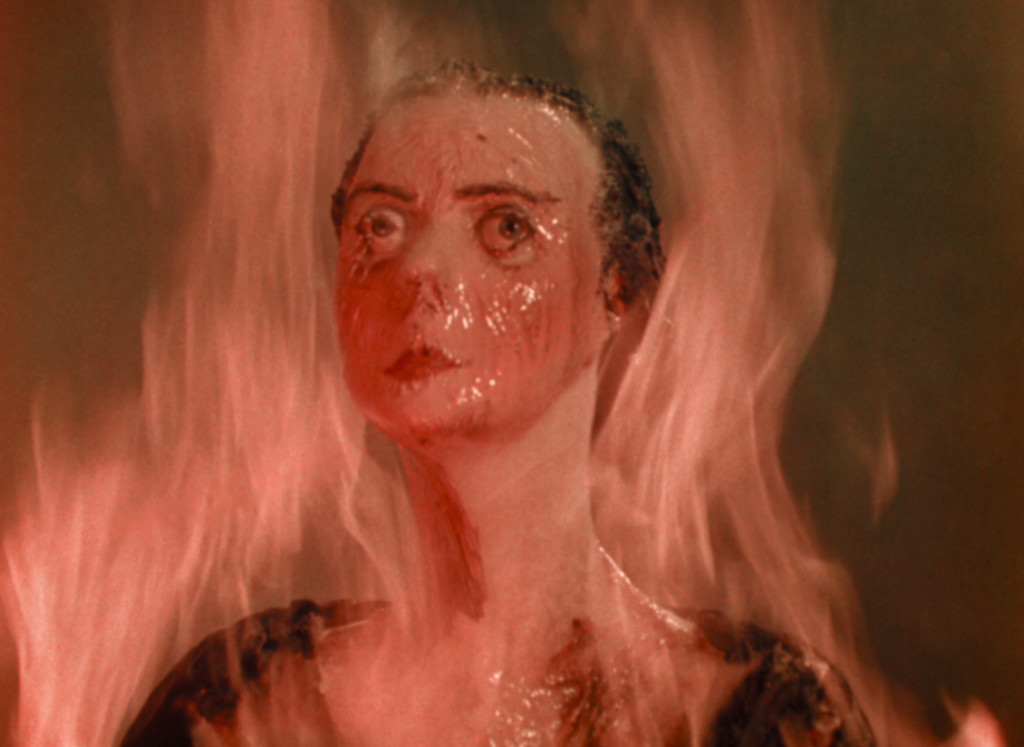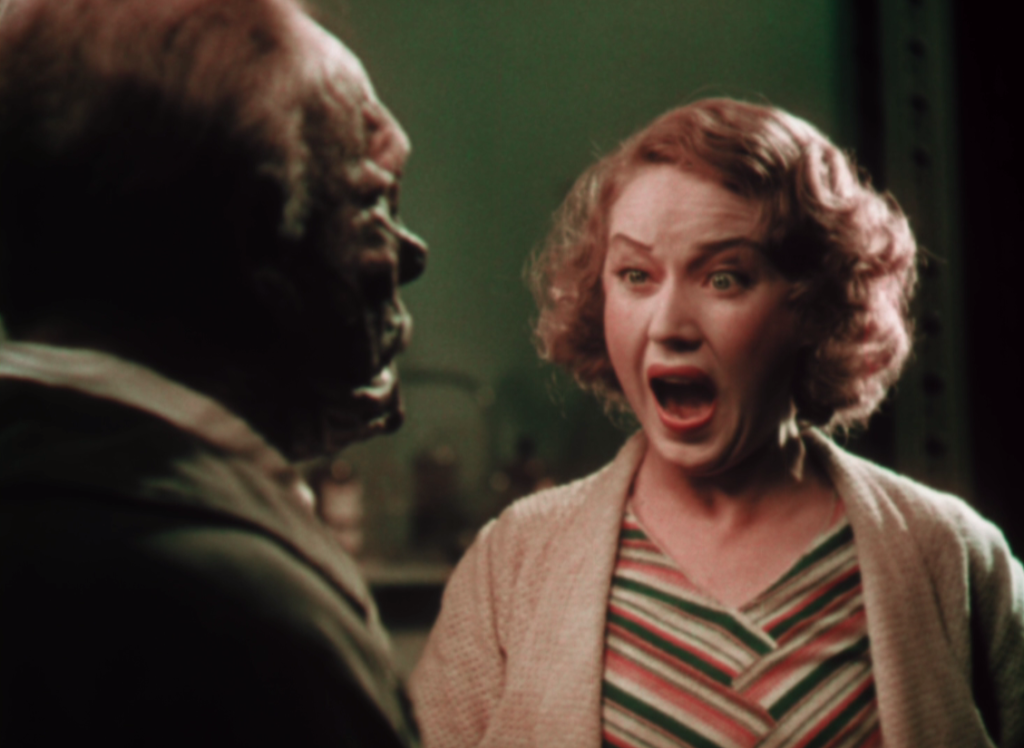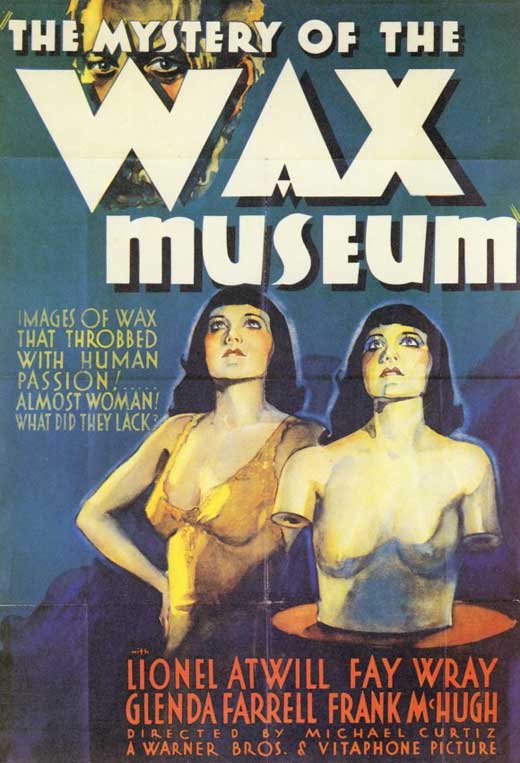
Essentially the second half of a diptych with the horror classic Doctor X (1932), The Mystery of the Wax Museum is another Warner Bros. horror film starring Lionel Atwill and Fay Wray, directed by the great Michael Curtiz, and filmed in an alluring enhanced version of the two-strip Technicolor Process 3 (which had also been used in 1931’s The Runaround and 1932’s Manhattan Parade). Best known for decades as the film which inspired Vincent Price’s 3-D remake House of Wax (1953), it’s risen to prominence as its own very special item in recent decades thanks to the resurfacing of the original color version and screenings on Turner Classic Movies. Now Warner Archive has released a dazzling Blu-ray of the meticulous 2019 restoration from the UCLA Film & Television Archive, which not only makes the Technicolor more vivid, but brings back sound effects heretofore smothered and even a bit of snipped dialogue. Thanks to Curtiz’s stylish direction and the labors of cinematographer and Technicolor specialist Ray Rennahan, Wax Museum, like Doctor X, take great strides over its contemporaries toward the kind of horror we’d see in decades to come, crossing into unreality and the grotesque with fast-paced zeal and emphasizing sensation over sense. Yet it also looks backward toward German Expressionism, borrows from the 30’s screwball comedy of The Front Page variety, and includes vintage pre-Code moments like references to drug addiction and dashes of voyeuristic sensuality.

Melting wax in the London-based prologue.
Atwill, who was enjoying a run in a number of macabre films including the same year’s The Vampire Bat, Murders in the Zoo, and Secret of the Blue Room, stars as Ivan Igor, a wax sculptor whose side street attraction in London is burned to the ground for its insurance money by his callous partner (Edwin Maxwell), who leaves an unconscious Ivan locked inside to burn to death. This prologue sets the mood nicely with the wax museum’s front entrance awash in eerie green lighting and the image of Maxwell waiting outside on a street corner, a menacing figure of mystery before he makes his formal entrance. When the conflagration begins, Curtiz offers close-ups of the melting wax faces, in stark contrast to the scenes staged with actors standing in for the wax figures (reportedly because the wax tended to melt beneath the hot, bright lights needed for the Technicolor filming). Twelve years later, we find Igor – wheelchair bound, unable to sculpt because of his burned hands, but otherwise apparently fine – presiding over a new museum set to debut in New York City. On New Year’s Eve, confetti falling like snow through the streets and revelers hanging out their windows to celebrate, the headlines tell of the suicide of celebrity Joan Gale (Monica Bannister). In the morgue, Joan’s body is stolen and lowered out the window by a monstrous figure. Florence (Glenda Farrell), a reporter eager for a big break to impress her editor (Frank McHugh) and save her job, investigates the vanished corpse, becoming convinced that there’s a bigger story here to be cracked open, while the police begin to suspect Joan of being murdered by a man (Gavin Gordon) whom Florence believes innocent. Her investigation turns to the wax museum, which employs apprentice sculptor Ralph (Allen Vincent), fiancé of her roommate Charlotte (Wray). Upon receiving a sneak preview of the attraction, Florence notices that the sculpture of Joan of Arc bears an uncanny resemblance to Joan Gale…

Charlotte (Fay Wray) discovers the true face of Ivan Igor (Lionel Atwill).
As the title indicates, this is a mystery, replete with red herrings, secret passages, and hidden bodies, though any modern viewer will know exactly where it’s going and what’s under the wax. It’s also, thanks to the wonderful performance of fast-talking Farrell, a perfectly functional newspaper yarn, although a half-hearted attempt at injecting some comedic romance in the closing frames is terribly miscalculated for either romance or laughs. If this is to be classified as a horror-mystery, note that the horror lands with much greater impact than the films of the era we’d associate with that subgenre. That’s because in such films the monster is usually unmasked as an everyday schemer; here, the man is unmasked as a monster – literally, as Wray claws through Atwill’s face and lets rip her trademark scream at the visage she finds underneath. Wray gets higher billing than Farrell, but she’s really a secondary character here, becoming a damsel in distress in the final act when she discovers a hidden, subterranean wax factory. Curtiz and art director Anton Grot (Doctor X, Svengali, Baby Face) carry us to this revelation down long crooked steps straight out of The Cabinet of Dr. Caligari and through womb-like passages until the bubbling vat of wax sits like a massive witch’s cauldron against a science fiction control room backdrop. Curtiz also serves up a towering deaf-mute named Hugo (Matthew Betz) employed as one of Igor’s sculptors, though – in a fine gag – he has a tendency to give the statues his own face. Setting the tone for future wax museum thrillers, Curtiz emphasizes the confusion between the real and the simulated, including a close-up of a blade being slipped into a bloody wound, which, when revealed in full, is an historical recreation of Marat being stabbed in his bath. In a film like this, the horror is self-reflexively part of the display (at one point Igor pompously dismisses the idea of lowbrow Chamber of Horror attractions, though his museum is not short on the macabre). The two-strip Technicolor process may seem crude by today’s standards of vivid HD, but the stylized colors enhance the sensation of watching a lurid entertainment just a step beyond the real – ideal to enjoy this restoration of the marvelous Mystery of the Wax Museum.










